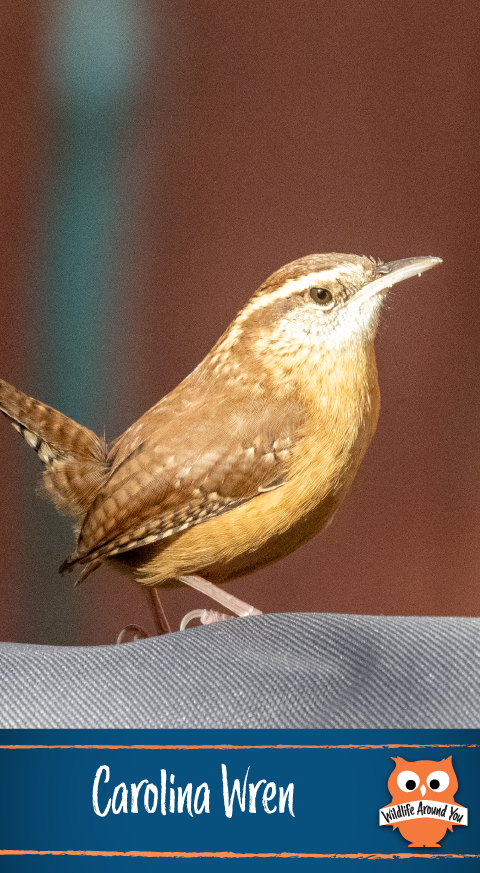Identification
Looks similar to House Wren and Bewick’s Wren. The easiest species to confuse with the Carolina wren is Bewick’s wren, which differs in being smaller but with a longer tail, grayer-brown above and whiter below. The Carolina and white-browed wrens differ from the house wren in being larger, with a decidedly longer bill and hind toe; their culmen has a notch behind the tip.(Culmen: Difficult to see on many bird species, the culmen is the center line drawn down the length of a bird’s maxilla. In some species, this can be a very distinct peak that divides the sides of the bill, while it may not be noticeable in other species.)
Small, chunky bird, slightly smaller than sparrows. It has a comparably long tail that is often cocked upward. The head is large and it looks like they don’t have a neck. Bill is curved slightly. Kind of a reddish-brown on top and light orange underneath with a long white eyebrow stripe, and white chin and throat. Can often hear it before you can see it.
Habitat
Dense vegetation in wooded areas and neighborhoods. They will move low through the understory and on the ground. Love areas with lots of vines and bushes.
Mainly found kind of East of the Great Plains and South of the Great Lakes and a little into Mexico. They don’t migrate but stay in their territory year round.
Nesting
They may nest in boxes or something as simple as an empty flowerpot if it’s in a safe quiet corner. If you have brush piles, they may invite themselves to your yard. Typically they nest about 3-6 feet off the ground in some sort of cavitity.
Male and females build their nests together. First nest could take a week or more to build, but later ones can be built in as little as four days.
It is usually cup shaped, domed with a side entrance and extension like a porch or ramp. Can be made from bark strips, grasses, leaves, hair, feathers, string, etc. A snake skin is often used as a building material. Nests can be 3-9 inches long and 3-6 inches wide.
Behavior
Can be seen hopping and creeping around vegetation and going up and down tree trunks looking for insects and fruit.
They will defend their territory and nest by constant singing and scolding of intruders.
They usually are solo searching for food unless it’s after nestlings have fledged, then you may see a family together.
They aren’t strong flyers, so they take quick brief flights over short distances.
Pairs will stay bonded year-round, forever.
They are rarely in the open for long, and if they are in the open they don’t seem to hold still.
Offspring
Has 1-3 broods of 3-7 eggs.
Gets are around 3/4inch
Incubation for 12-15 days
Nestlings for 10-16 days
Both parents bring food for the young.
Predators
Hawks, blue jays, domestic cats, snakes, and raccoons. Cowbirds can cause problems with the nesting as well.
Diet
Primarily insects and spiders. Common foods include caterpillars, moths, stick bugs, leafhoppers, beetles, grasshoppers, crickets, and cockroaches. Carolina Wrens occasionally eat lizards, frogs, or snakes. They also consume a small amount of plant matter, such as fruit pulp and seeds or berrys from nearby plants. Will visit suet feeders during winter, and will frequent backyards if food is available.
Fun Facts
Often holds its tail upward when foraging and down when singing.
They are sensitive to the cold, and a strong cold snap can wipe them out of an area for a time. They seem to recover fairly well though.
One captive male sang nearly 3.000 times in a single day.
The male is the loud singer. and has a repertoire of at least twenty different phrase patterns.
Oldest recorded carolina wren varies based on the source. Somewhere between 6 and 10 years.
It is the state bird of South Carolina

